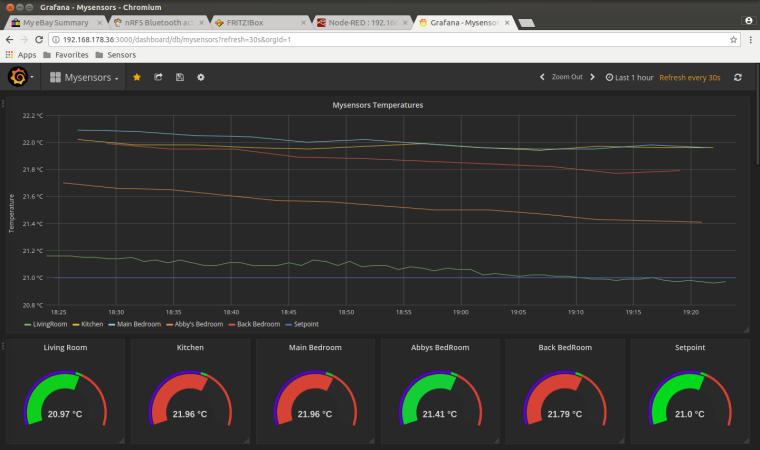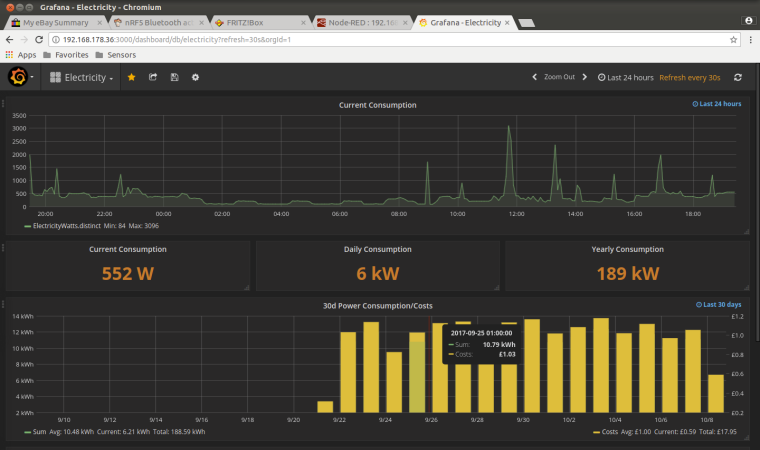nRF5 action!
-
The passive part for switching between antennas is a 0ohm resistor I think. Depends on the circuit, but it makes sense (I designed a few boards with pcb ant + uFl, and I do the same).
I bought this antenna a while ago, for testing/tuning purposes..
(in case, I have not yet compared range vs others antenna ;) )
Looks the same as @NeverDie ordered, except this one is wideband 700 to 2600Mhz which is pretty cool :)https://www.passion-radio.com/gb/wide-band/umts-magnetic-314.html
-
@Uhrheber
i'm using it in a simple way, with rtl-sdr, and for its versatility.
they say 9dB, but I don't really mind about that. It would not change anything to connect it for increasing range of 4db nrf52.
I'm just interested in the overall quality, as it's mostly for receiving with rtl, and doing checks etc.
I'm also planning to test other types of antenna, and build one for discovery.It's not for my HA network, of course it would be too bulky ;)
-
I received this from Amazon today and hooked an Ebyte nRF52832 (with the switched capacitor) into it:
https://www.amazon.com/gp/product/B01B94U438/ref=oh_aui_detailpage_o00_s00?ie=UTF8&psc=1It actually does extend range. Not as well as I had hoped, but better than this high gain antenna, which I also received today and which, in comparison, I would call little better than a placebo:
https://www.amazon.com/gp/product/B073SWWMRG/ref=oh_aui_detailpage_o00_s00?ie=UTF8&psc=1Soooo... With the bad news just received about the nRF51 (above) being limited to 4ms of Tx time at a time.... I guess it's time for this as Plan B on an nRF52832 gateway. Unless someone has a better idea. What I do like about it, given that it is a bolt-on, is that it senses when the nRF52832 begins to transmit, and only switches on the PA then. The rest of the time its in receive mode.
@NeverDie said in nRF5 Bluetooth action!:
It actually does extend range. Not as well as I had hoped, but better than this high gain antenna, which I also received today and which, in comparison, I would call little better than a placebo:
https://www.amazon.com/gp/product/B073SWWMRG/ref=oh_aui_detailpage_o00_s00?ie=UTF8&psc=1Those 2.4GHz pseudo stocked dipole antennas have always been crap.
Even if they had 9dBi, they'd lose most of it because of the thin lossy cables.
Never combine a high gain antenna with a long cheap cable, it's a waste of money.Most better patch antennas work quite well, as do parabolic and backfire types.
I have a 16dBi patch antenna, that works amazingly well. I can, from inside the house, see WiFi APs that are kilometers away.If you're on a budget, build a cantenna. If not, buy a not too cheap patch antenna.
-
@Uhrheber
i'm using it in a simple way, with rtl-sdr, and for its versatility.
they say 9dB, but I don't really mind about that. It would not change anything to connect it for increasing range of 4db nrf52.
I'm just interested in the overall quality, as it's mostly for receiving with rtl, and doing checks etc.
I'm also planning to test other types of antenna, and build one for discovery.It's not for my HA network, of course it would be too bulky ;)
@scalz For rtlsdr, I once bought one of those (outdoor) scanner antennas, that claim to be usable from 20MHz to 2GHz, only to find out, that a simple coat hanger antenna made from coax performs ways better.
I can even receive the NOAA satellites with it. -
The passive part for switching between antennas is a 0ohm resistor I think. Depends on the circuit, but it makes sense (I designed a few boards with pcb ant + uFl, and I do the same).
I bought this antenna a while ago, for testing/tuning purposes..
(in case, I have not yet compared range vs others antenna ;) )
Looks the same as @NeverDie ordered, except this one is wideband 700 to 2600Mhz which is pretty cool :)https://www.passion-radio.com/gb/wide-band/umts-magnetic-314.html
@scalz said in nRF5 Bluetooth action!:
The passive part for switching between antennas is a 0ohm resistor I think.
Thanks! That would make all the difference, because it will be a lot easier to solder bridge the new connection than it is to re-position an itty-bitty cap.
-
@NeverDie said in nRF5 Bluetooth action!:
It actually does extend range. Not as well as I had hoped, but better than this high gain antenna, which I also received today and which, in comparison, I would call little better than a placebo:
https://www.amazon.com/gp/product/B073SWWMRG/ref=oh_aui_detailpage_o00_s00?ie=UTF8&psc=1Those 2.4GHz pseudo stocked dipole antennas have always been crap.
Even if they had 9dBi, they'd lose most of it because of the thin lossy cables.
Never combine a high gain antenna with a long cheap cable, it's a waste of money.Most better patch antennas work quite well, as do parabolic and backfire types.
I have a 16dBi patch antenna, that works amazingly well. I can, from inside the house, see WiFi APs that are kilometers away.If you're on a budget, build a cantenna. If not, buy a not too cheap patch antenna.
@Uhrheber said in nRF5 Bluetooth action!:
I have a 16dBi patch antenna, that works amazingly well. I can, from inside the house, see WiFi APs that are kilometers away.
Do you have a link to the one you purchased? Rather than rolling the dice again, I'd rather get something that's "known good".
-
@NeverDie said in nRF5 Bluetooth action!:
It actually does extend range. Not as well as I had hoped, but better than this high gain antenna, which I also received today and which, in comparison, I would call little better than a placebo:
https://www.amazon.com/gp/product/B073SWWMRG/ref=oh_aui_detailpage_o00_s00?ie=UTF8&psc=1Those 2.4GHz pseudo stocked dipole antennas have always been crap.
Even if they had 9dBi, they'd lose most of it because of the thin lossy cables.
Never combine a high gain antenna with a long cheap cable, it's a waste of money.Most better patch antennas work quite well, as do parabolic and backfire types.
I have a 16dBi patch antenna, that works amazingly well. I can, from inside the house, see WiFi APs that are kilometers away.If you're on a budget, build a cantenna. If not, buy a not too cheap patch antenna.
@Uhrheber said in nRF5 Bluetooth action!:
Those 2.4GHz pseudo stocked dipole antennas have always been crap.
Even if they had 9dBi, they'd lose most of it because of the thin lossy cables.
Never combine a high gain antenna with a long cheap cable, it's a waste of money.Has anyone found a source for good quality pre-made cables with the connectors already attached? Again, I'd prefer to buy a "known good" product from a known good source than to keep rolling the dice.
-
Here's something which seems odd: I removed the bridge resistor from the Ebyte nRF52832, so that there was no soldered connection left. Then I checked it with my continuity meter, and they show connected anyway! Not really believing it, I tried it on a second module also, with the same result.
So, this means that the trace which is intended to go to the antenna is already connected to ground. Should it be? It doesn't seem right to me, but then I'm no expert.
Anyone?
-
By the way, from reading the instructions which came with the 4w booster, the recommended power input into it is between 7dbm and 20dbm. Obviously, the nRF52832 is 4dbm maximum, so this probably explains why the product is not excellent in this configuration. Bottom line: I don't think it's the solution.
-
Here's something which seems odd: I removed the bridge resistor from the Ebyte nRF52832, so that there was no soldered connection left. Then I checked it with my continuity meter, and they show connected anyway! Not really believing it, I tried it on a second module also, with the same result.
So, this means that the trace which is intended to go to the antenna is already connected to ground. Should it be? It doesn't seem right to me, but then I'm no expert.
Anyone?
@NeverDie from what I see in the picture of this module, it is using a Meandering Inverted F antenna. Part of that antenna is connected to ground. So you will measure a DC ground from anywhere along the antenna to ground.0_1507315872619_Ember -inverted F_120-5052-000_Designing_with_a_PCB_Antenna.pdf
-
Finally found some nRF52832 modules with a PA that doesn't require a minimum order of 5 units:
-
Finally found some nRF52832 modules with a PA that doesn't require a minimum order of 5 units:
-
@Jokgi said in nRF5 Bluetooth action!:
@NeverDie Is there a schematic available?
Not that I've seen, but there is this, which has a bit more info: https://www.aliexpress.com/store/product/PTR9618PA-Nordic-nRF52832-Module-PA-module-BLE-4-0-Module-Free-shipping/130096_32758834433.html
Taken at face value, it seems to imply that the unit includes DCDC regulation, that it does not include an external low frequency oscillator, and that pin P0.24 is used to enable/disable the PA.
-
@Jokgi said in nRF5 Bluetooth action!:
@NeverDie Is there a schematic available?
Not that I've seen, but there is this, which has a bit more info: https://www.aliexpress.com/store/product/PTR9618PA-Nordic-nRF52832-Module-PA-module-BLE-4-0-Module-Free-shipping/130096_32758834433.html
Taken at face value, it seems to imply that the unit includes DCDC regulation, that it does not include an external low frequency oscillator, and that pin P0.24 is used to enable/disable the PA.
-
@Uhrheber said in nRF5 Bluetooth action!:
I have a 16dBi patch antenna, that works amazingly well. I can, from inside the house, see WiFi APs that are kilometers away.
Do you have a link to the one you purchased? Rather than rolling the dice again, I'd rather get something that's "known good".
@NeverDie
I bought it used on ebay, for little money.
But generally you can assume that everything that comes with an N connector is meant for (semi-) professional use.Conversely, avoid everything that comes with a reverse-SMA connector and/or a thin cable.
It's usually crap. -
@NeverDie The datasheet is here: http://www.freqchina.com/plus/view.php?aid=1083
(Click on the "Data" tab.)
@Uhrheber said in nRF5 Bluetooth action!:
@NeverDie The datasheet is here: http://www.freqchina.com/plus/view.php?aid=1083
(Click on the "Data" tab.)
Thanks! Just in time too, as it looks as though pin P0.20 is reserved also.
I just now did a breakout board for it. If anyone is interested in it, I can post it.
-
Plugged my NRF51822 board into a cr2032 button battery and it is sending voltage/Rssi/Random Temperature every 1min.
Just to see how low it goes and how long.
I also changed my controller over to Grafana and influxdb/Node-red.
So far i am suitably impressed.


-
Plugged my NRF51822 board into a cr2032 button battery and it is sending voltage/Rssi/Random Temperature every 1min.
Just to see how low it goes and how long.
I also changed my controller over to Grafana and influxdb/Node-red.
So far i am suitably impressed.


-
@NeverDie
I bought it used on ebay, for little money.
But generally you can assume that everything that comes with an N connector is meant for (semi-) professional use.Conversely, avoid everything that comes with a reverse-SMA connector and/or a thin cable.
It's usually crap.@Uhrheber said in nRF5 Bluetooth action!:
Conversely, avoid everything that comes with a reverse-SMA connector and/or a thin cable.
It's usually crap.I changed the connection from the nRF52832 to the 4w booster over to this:
https://www.amazon.com/gp/product/B06WGY8FJB/ref=oh_aui_detailpage_o01_s00?ie=UTF8&psc=1
and it was an improvement. I can't help but wonder now whether an even thicker cable would work even better? What's a good source for getting even better (and thicker) cabling solutions of this type? -
What are you using as the "controller" then? Is it Node Red? The other two aren't listed on the Mysensors controller page.
